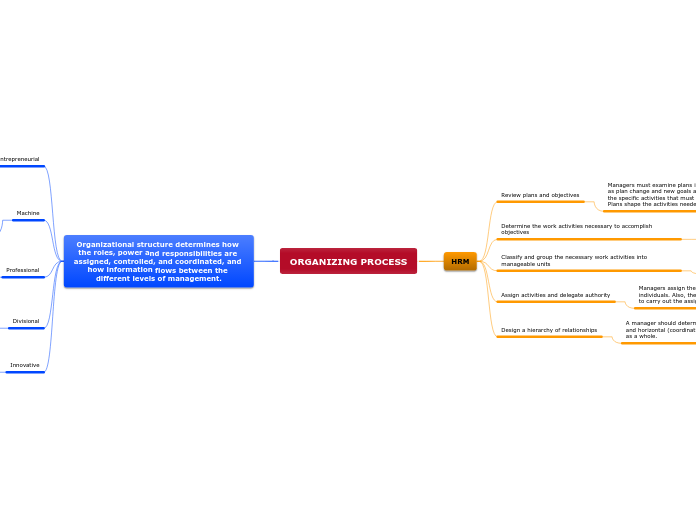ORGANIZING PROCESS
HRM
Review plans and objectives
Managers must examine plans initially and continue to do so as plan change and new goals are developed. Objectives are the specific activities that must be completed to achieve goals. Plans shape the activities needed to reach those goals.
Determine the work activities necessary to accomplish objectives
Managers simply list and analyze all the tasks that need to be accomplished in order to reach organizational goals.
Classify and group the necessary work activities into manageable units
A manager can group activities based on four models of departmentalization: functional, geographical, product, and customer
Assign activities and delegate authority
Managers assign the defined work activities to specific individuals. Also, they give each individual the authority (right) to carry out the assigned tasks.
Design a hierarchy of relationships
A manager should determine the vertical (decision‐making) and horizontal (coordinating) relationships of the organization as a whole.
Organizational structure determines how the roles, power and responsibilities are assigned, controlled, and coordinated, and how information flows between the different levels of management.
Entrepreneurial
An entrepreneurial company has a loose organizational structure and is typically driven by entrepreneurial-minded or creative types of leaders. Limited structure, poor task discipline, inefficiency and controlling management are potential drawbacks or risks if emphasis isn't placed on defined work processes.
Machine
Some company defined organization as being like a "machine." Government agencies and other types of large, set-in-their-ways corporations epitomize this style. While structure, consistency and longevity are strengths, limited openness to new perspectives and inefficiencies resulting from bureaucratic processes are common deficiencies.
Professional
This professional organization type has a similar level of bureaucracy to the machine type. However, it is characterized by a high degree of professional, competent knowledge workers who drive the economic engine. These technically skilled workers usually have specialized skills and autonomy in their work. It also making for more decentralized decision making than is prevalent in the machine type.
Divisional
A divisional structure is most common in large corporations with multiple business units and product lines. In some cases, companies divide their businesses and products into divisions to promote specific management of each division.
Innovative
This is common in new industries or with companies that want to become innovative leaders. Decentralized decision making is a key trait as talent leaders are allowed to make judgments with efficiency in mind. The potential for leadership conflict and uncertainty over authority are drawbacks.
